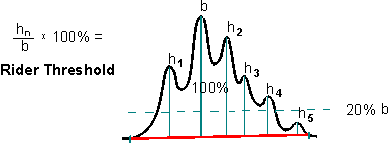Location:
Detection tab page
Report Variable (Detection Parameters)
Type:
Fixed point number
Dimension:
Percent [%]
Value Range:
0.00 ... 100.00
Default:
10.00
Related Parameters:
Description:
The Rider Threshold and Maximum Rider Ratio variables determine whether a single peak in a series of non-resolved peaks is classified as a Rider Peak (skimming peak) or as main peak.
Function:
The ratio between the Peak Height of the single peaks (here: h1 to h5) and the height of the largest peak (here: b) determines whether a peak is classified as rider peak or main peak.

If the height ratio h/b multiplied by 100 percent produces a value below the defined rider threshold, the corresponding peak is a main peak by definition. In this example, this is only the case for the h5 peak.
If the height ratio h/b multiplied by 100 percent produces a value above the defined rider threshold, the Rider Threshold criterion is not sufficient for a clear classification.
In this case, the Maximum Rider Ratio is established. The resulting value allows you to classify the remaining peaks as rider peaks or main peaks.
Riders can be recognized as such by the skimming tangent drawn on the chromatogram plot and by a Ru (Rider up) or Rd (Rider down) entry in the Type column of the report (Integration tab page).
![]() Notes:
Notes:
In order to be effective, the criterion must be enabled before the peak start!
The Type (Peak Type) classification criterion in the peak table has priority! The criterion specified here, is effective only together with PEAK TYPE = AUTO!